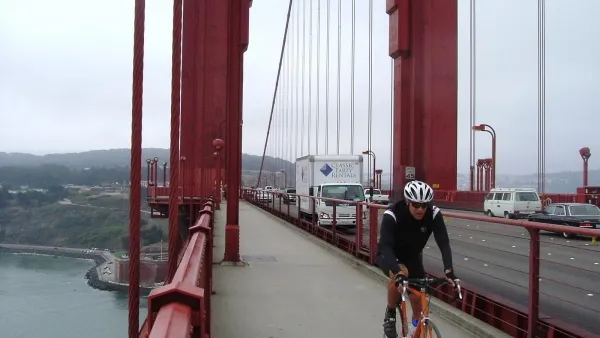The concept of tolling sidewalk access to the Golden Gate Bridge squeaked by on a 10-9 vote on Oct. 24. The GGB Transportation and Highway District wants to consider the toll as a potential contributor to reducing the $33 million, five-year deficit.
The district's Board of the Directors split their vote "almost entirely along San Francisco versus North Bay lines," writes John Coté of the San Francisco Chronicle, with most of the San Francisco directors opposed to studying the fee. In addition to the operating deficit, the district must "deal with $209 million unfunded capital needs."
As noted here Wednesday, "(f)rom May 1937 to December 1970, a pedestrian toll was charged and collected via a coin turnstile."
According to Mark Prado of the Marin Independent Journal, "(p)ersonnel costs, the seismic retrofit of the span, a $75 million bill to help pay for the ongoing Doyle Drive upgrade, south tower painting and the partial loss of revenue from a downsized local bus contract with Marin County have fueled the district's deficit, bridge officials have said."
Yet opposition to charging the sidewalk toll has centered on the issue of road maintenance, not even mentioned above.
“I think it’s just not a good idea at all,” said Supervisor Scott Wiener. “Cars and trucks are what put the wear and tear on (the bridge). Walkers don’t put wear and tear on it. ... We want people to walk and bike. Charging people to do that doesn’t make sense to me.”
Taking an opposing view was Director John Moylan, also of San Francisco, though not an elected official.
“We’re all in this together,” Moylan said. “It’s not fair, in my opinion, that the people who drive into San Francisco pay for everything.”
"A $1 toll increase went into effect April 1 and drivers will see a 25 cent increase to the toll each year through 2018, bringing the FasTrak toll to $7 and the pay-by-plate toll to $8 by July of that year," wrote Prado [see toll rates]. "Transit fares on district buses and ferries could also continue to rise 5 percent a year."
"Bridge district staff now has until 2017 to research charging pedestrian and cyclists to cross, including how much the fee would be and how much revenue it might raise, and present their findings to the board, which could then vote on whether to start charging bikers and walkers to cross," writes Coté.
FULL STORY: Golden Gate Bridge board keeps sidewalk toll on table, OKs study

National Parks Layoffs Will Cause Communities to Lose Billions
Thousands of essential park workers were laid off this week, just before the busy spring break season.

Retro-silient?: America’s First “Eco-burb,” The Woodlands Turns 50
A master-planned community north of Houston offers lessons on green infrastructure and resilient design, but falls short of its founder’s lofty affordability and walkability goals.

Delivering for America Plan Will Downgrade Mail Service in at Least 49.5 Percent of Zip Codes
Republican and Democrat lawmakers criticize the plan for its disproportionate negative impact on rural communities.

Test News Post 1
This is a summary

Test News Headline 46
Test for the image on the front page.

Balancing Bombs and Butterflies: How the National Guard Protects a Rare Species
The National Guard at Fort Indiantown Gap uses GIS technology and land management strategies to balance military training with conservation efforts, ensuring the survival of the rare eastern regal fritillary butterfly.
Urban Design for Planners 1: Software Tools
This six-course series explores essential urban design concepts using open source software and equips planners with the tools they need to participate fully in the urban design process.
Planning for Universal Design
Learn the tools for implementing Universal Design in planning regulations.
EMC Planning Group, Inc.
Planetizen
Planetizen
Mpact (formerly Rail~Volution)
Great Falls Development Authority, Inc.
HUDs Office of Policy Development and Research
NYU Wagner Graduate School of Public Service



























